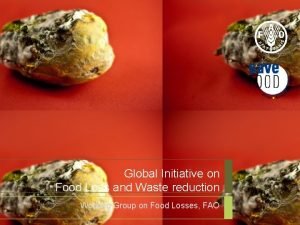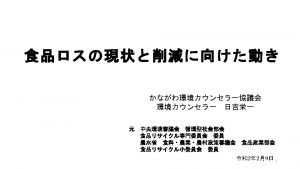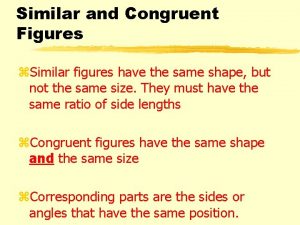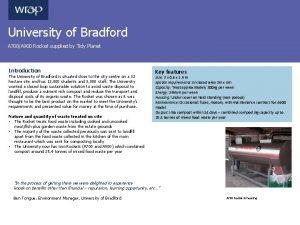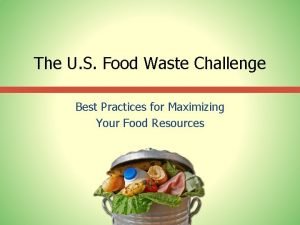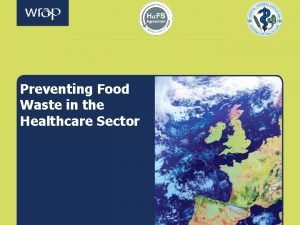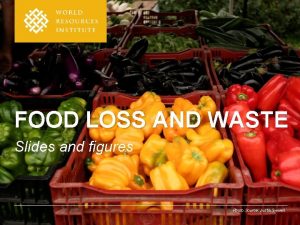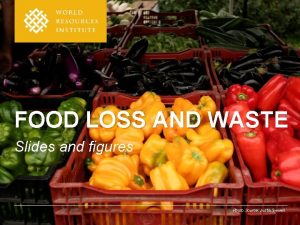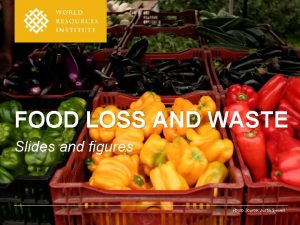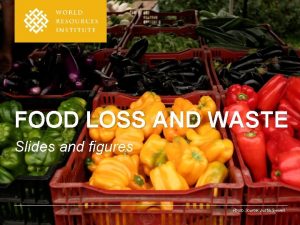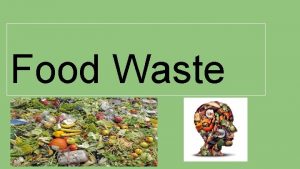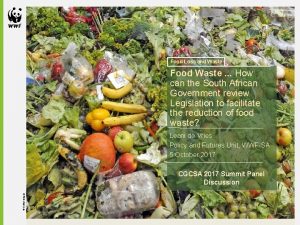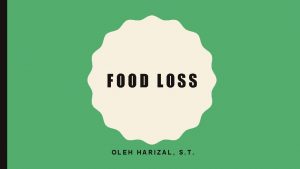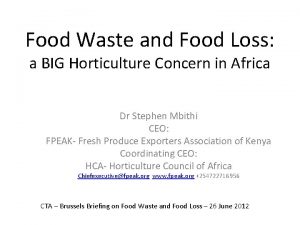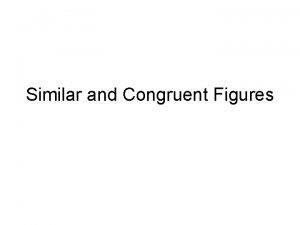FOOD LOSS AND WASTE Slides and figures Photo














- Slides: 14

FOOD LOSS AND WASTE Slides and figures Photo Source: Justin Sewell

A significant share of food intended for human consumption is lost or wasted from the farm to the fork 32% of global food supply by weight 24% of global food supply by energy content (calories) Source: WRI analysis based on FAO. 2011. Global food losses and food waste – extent, causes and prevention. Rome: UN FAO.

Food is lost or wasted along the entire value chain During or immediately after harvesting on the farm After leaving the farm for handling, storage, and transport During industrial or domestic processing and/or packaging During distribution to markets, including at wholesale and retail markets Source: WRI analysis based on FAO. 2011. Global food losses and food waste – extent, causes and prevention. Rome: UN FAO. In the home or business of the consumer, including restaurants and caterers

Food loss and waste occurs more ‘near the fork’ in developed regions and more ‘near the farm’ in developing regions 100% = 1. 5 quadrillion kcal Source: WRI analysis based on FAO. 2011. Global food losses and food waste – extent, causes and prevention. Rome: UN FAO.

Losses at production are more prevalent in developing regions while food waste at consumption is more prevalent in developed regions (Percent of kcal lost and wasted) Note: Number may not sum to 100 due to rounding. Source: WRI analysis based on FAO. 2011. Global food losses and food waste – extent, causes and prevention. Rome: UN FAO.

Cereals comprise the most loss and waste when measured by calories, while fruits and vegetables by weight Source: WRI analysis based on FAO. 2011. Global food losses and food waste—extent, causes and prevention. Rome: UN FAO.


TARGET 12. 3 By 2030, halve per capita global food waste at the retail and consumer levels and reduce food losses along production and supply chains, including post-harvest losses

Champions 12. 3 is a unique coalition of leaders dedicated to inspiring ambition, mobilizing action, and accelerating progress toward achieving SDG Target 12. 3

Champions 12. 3 Dave Lewis CEO Tesco Chair of Champions 12. 3 Shenggen Fan Director General International Food and Policy Research Institute Michel Landel CEO Sodexo Group Peter Freedman Managing Director The Consumer Goods Forum Esben Lunde Larsen Minister Ministry of Environment and Food, Denmark Cao Duc Phat Former Minister, Ministry of Agriculture and Rural Development, Vietnam 5 Erik Solheim Executive Director UNEP Co-Chair of Champions 12. 3 Oyun Sanjaasuren President 2 nd United Nations Environment Assembly Paul Polman CEO Unilever Vytenis Andriukaitis Commissioner for Health and Food Safety European Commission Louise Fresco President Wageningen University & Research Gina Mc. Carthy Former Administrator U. S. Environmental Protection Agency Juan Lucas Restrepo Ibiza Chairman Global Forum on Agricultural Research Lindiwe Majele Sibanda CEO & Head of Mission Food, Agriculture & Nat. Resource Policy Network Peter Bakker President World Business Council for Sustainable Development Liz Goodwin Senior Fellow and Director, Food Loss and Waste WRI John Bryant Chairman of the Board Kellogg Company Hans Hoogeveen Ambassador and Permanent Representative of the Netherlands to UN Organizations for Food and Agriculture José Antonio Meade Secretary Secretariat of Finance and Public Credit, Mexico Denise Morrison President and CEO Campbell Soup Company Judith Rodin President Rockefeller Foundation Achim Steiner Director Oxford Martin School, Oxford University Feike Sijbesma CEO Royal DSM Andrew Steer President and CEO World Resources Institute Paul Bulcke CEO Nestlé S. A. Marcus Gover Chief Executive Officer WRAP Wiebe Draijer Chairman of the Executive Board Rabobank Yolanda Kakabadse President WWF International Sam Kass Senior Food Analyst NBC News (former White House chef) Rafael Pacchiano Kanayo F. Nwanze Raymond Offenheiser Secretary, Department of President Environment & Natural International Fund for Oxfam America Resources, Mexico Agricultural Development Tristram Stuart Founder Feedback Sunny Verghese CEO and Co-Founder Olam International Rhoda Peace Tumusiime Rhea Suh Commissioner for President Natural Resources Rural Economy and Agriculture African Union Defense Council Tom Vilsack Former Secretary U. S. Department of Agriculture Senzeni Zokwana Minister Ministry of Agriculture, Forestry and Fisheries, South Africa

What Champions do Dedicate to SDG Target 12. 3 Lead by example Showcase successes Advocate for enabling conditions Achieve concrete results

Possible approaches for reducing food loss and waste NOT EXHAUSTIVE (not exhaustive) During or immediately after harvesting on the farm After leaving the farm for handling, storage, and transport During industrial or domestic processing and/or packaging Provide information on how to use unmarketable crops Improve storage technologies (e. g. , evaporative coolers, storage bags, metal silos, crates) Improve agriculture extension services During distribution to markets, including at wholesale and retail markets In the home or business of the consumer, including restaurants and caterers Re-engineer manufacturing processes Facilitate increased donation of unsold goods Conduct consumer education campaigns Introduce low-carbon cold chains Improve supply chain management Provide guidance on food storage and preparation to consumers Improve consumer cooking skills Improve access to infrastructure and markets Improve handling Improve packaging to keep food fresher for longer and optimize portion size Change food date labeling practices Reduce portion sizes Improve harvesting techniques Improve infrastructure (e. g. , roads) Change in-store promotions Eat “ugly” produce

Source: Re. FED. 2016. A Roadmap to Reduce U. S. Food Waste by 20 Percent.

United States Source: Re. FED. 2016. A Roadmap to Reduce U. S. Food Waste by 20 Percent.
 Global initiative on food loss and waste reduction
Global initiative on food loss and waste reduction Food loss and waste
Food loss and waste Unit cost meaning
Unit cost meaning A small child slides down the four frictionless slides
A small child slides down the four frictionless slides A crane lowers a girder into place
A crane lowers a girder into place Congruent figures and similar figures
Congruent figures and similar figures A polygon with eight sides and eight angles
A polygon with eight sides and eight angles Coordinate plane jeopardy
Coordinate plane jeopardy Unit 2 food food food
Unit 2 food food food Food chain food chain food chain
Food chain food chain food chain Food waste bradford
Food waste bradford Der deutsche student translation
Der deutsche student translation Food waste management software
Food waste management software Food is ammunition don't waste it meaning
Food is ammunition don't waste it meaning Food waste management system
Food waste management system
